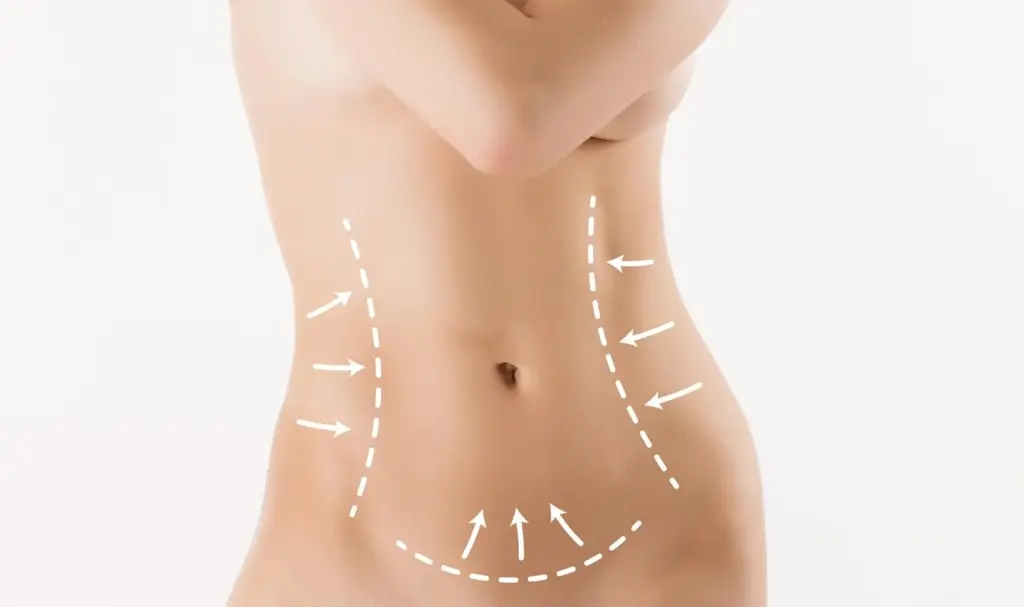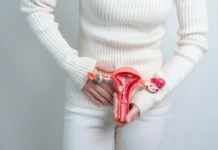Liposuction, also referred to as lipoplasty, is a surgical technique designed to eliminate excess fat from specific regions of the body. This procedure ranks among the most sought-after cosmetic surgeries in the United States, commonly employed to reshape areas like the abdomen, hips, thighs, buttocks, upper arms, and neck.
It’s crucial to note that liposuction is not intended as a method for weight loss or a replacement for proper diet and exercise. Instead, it serves as a valuable tool for individuals facing challenges in shedding fat from particular problem areas or those seeking enhanced body contouring.
How Liposuction is Performed
Liposuction is carried out under either general anaesthesia or local anesthesia coupled with sedation. The surgeon initiates the procedure by making a small incision in the sagging skin and inserting a slender tube known as a cannula through the incision. This cannula is connected to a vacuum apparatus, which extracts the excess body fat cells.
Types of Liposuction
There are various forms of lipoplasty, including:
- Traditional Liposuction: This is the most prevalent type, wherein the surgeon inserts a cannula into the targeted area and oscillates it to break down the fat cells. The fat cells are subsequently removed via the cannula’s suction.
- Tumescent Liposuction: This method incorporates a tumescent solution composed of saline, lidocaine, and epinephrine, which is injected into the target area. This solution serves to anaesthetize the region and minimize bleeding. Following this, the surgeon inserts a cannula to extract the fat cells.
- Power-Assisted Liposuction (PAL): PAL employs a vibrating cannula to disintegrate the fat cells, facilitating their suction.
- Ultrasound-Assisted Liposuction (UAL): UAL employs ultrasonic energy to liquefy the fat cells, making them easier to extract.
- Laser-Assisted Liposuction (LAL): LAL uses laser energy to liquefy the fat cells before their removal.
Risks and Side Effects of Liposuction
While suction lipectomy is generally considered a safe surgical procedure, it does carry some potential risks and side effects, including:
- Bleeding
- Infection
- Seroma (accumulation of fluid)
- Nerve damage
- Asymmetry
- Skin irregularities
Is suction lipectomy the right choice for you?
Liposuction is a suitable option for individuals in good health who maintain realistic expectations regarding the outcomes of the surgery. It is not recommended for individuals who are obese or those with underlying medical conditions such as diabetes or heart disease.
If you are contemplating liposuction, it is vital to consult with a board-certified plastic surgeon. This consultation will provide an opportunity to discuss your objectives and gain a comprehensive understanding of the procedure’s associated risks and benefits.
What is liposuction?
Liposuction, also known as lipoplasty, is a cosmetic surgical procedure designed to eliminate unwanted fat deposits from your body. It’s important to note that liposuction is not a method for weight loss; rather, it focuses on enhancing your body’s shape by targeting persistent fat that remains unresponsive to diet and exercise.
Liposuction is typically conducted under general anaesthesia, although local anaesthesia may be employed for smaller-scale procedures. During the surgery, your surgeon will create small incisions in your skin and introduce a slender tube known as a cannula into the fatty tissue. This cannula is connected to a vacuum device that effectively suctions out the excess fat.
Various techniques of liposuction exist, but one of the most prevalent is tumescent liposuction. In this approach, your surgeon administers a sterile solution into the treatment area, which includes saline, lidocaine (a local anaesthetic), and epinephrine. This solution serves to numb the area, minimize bleeding, and facilitate the removal of fat.
Which body areas can benefit from liposuction?
Liposuction can be employed to address numerous areas of the body, including:
- Abdomen
- Hips and thighs
- Buttocks
- Back
- Arms
- Neck
- Chin
Who is a suitable candidate for liposuction?
Liposuction is an appropriate choice for individuals who:
- Maintain a healthy weight but grapple with stubborn fat deposits resistant to diet and exercise efforts.
- Possess realistic expectations concerning the outcome of the surgery.
- Enjoy overall good health without any underlying medical conditions that might pose a risk during surgery.
VASER Liposuction: What You Need to Know

VASER liposuction stands as a cutting-edge, minimally invasive cosmetic procedure harnessing ultrasound technology to eliminate stubborn fat beneath the skin’s surface. It distinguishes itself as a gentler and more controlled alternative to traditional lipoplasty, allowing precise targeting of specific body areas, such as the arms, chest, abdomen, hips, and thighs.
How VASER Liposuction Works
The VASER liposuction procedure involves the insertion of a slender probe through a small incision into the dry skin. This probe emits ultrasound waves that effectively break down fat cells. Subsequently, the liquefied fat is gently removed from the body through the use of a cannula.
Advantages of VASER Liposuction
VASER liposuction offers several advantages over its conventional counterpart, including:
- Enhanced Precision in Fat Removal
- Reduced Bleeding and Bruising
- Quicker Healing Period
- Decreased Risk of Complications
- Improved Skin Smoothness
Post-VASER Liposuction Expectations
Following VASER liposuction, one can anticipate some degree of bruising and swelling in the treated area. Wearing a compression garment for several weeks is recommended to minimize swelling. Most individuals can return to work within a few days, although strenuous activities should be avoided for several weeks.
Longevity of VASER Liposuction Results
The results of VASER liposuction are permanent. Nonetheless, it remains crucial to maintain a healthy diet and exercise regimen to prevent weight gain and the development of new fat deposits.
Body Contouring with Liposuction

Liposuction is a surgical procedure designed to eliminate surplus fat from the body. It ranks among the most sought-after cosmetic surgery procedures worldwide, offering the potential to reshape and contour various body regions, including the abdomen, hips, thighs, buttocks, arms, neck, and face.
How Liposuction Works
Liposuction necessitates general anaesthesia for its execution. The surgeon initiates the procedure by making a small incision in the skin, through which a slender tube, known as a cannula, is inserted into the fatty tissue. This cannula is connected to a vacuum device that effectively suctions out the fat cells.
Several distinct techniques are employed in liposuction, including:
- Traditional liposuction: Utilizing a handheld cannula to dislodge and extract fat cells, this method is the most prevalent.
- Tumescent liposuction: This variant entails the injection of a saline solution into the fatty tissue to tumble, or swell, the area, facilitating fat cell removal.
- Power-assisted liposuction (PAL): Employing a vibrating cannula to loosen fat cells before extraction
- Laser-assisted liposuction (LAL): Utilizing laser energy to liquefy fat cells before suctioning them out
Advantages of Liposuction
Liposuction offers numerous benefits, including:
- Enhanced Body Contour: The procedure effectively targets persistent fat deposits that resist conventional diet and exercise, resulting in a more sculpted and defined physique.
- Improved Self-Confidence: Liposuction can significantly boost self-esteem and body image.
- Enhanced Health: By reducing the risk of obesity-related chronic illnesses like heart disease, stroke, and type 2 diabetes, liposuction can contribute to improved health.
Risks Associated with Liposuction
While liposuction is a generally safe procedure, it does carry some inherent risks, such as:
- Bleeding: Liposuction can cause minor bleeding, typically manageable with pressure bandages.
- Infection: Although rare, infections can occur post-liposuction, with antibiotics prescribed to mitigate this risk.
- Swelling and Bruising: Common side effects, swelling, and bruising usually resolve within a few weeks.
- Rippling or Uneven Skin: In isolated cases, liposuction may result in combination skin irregularities due to uneven fat removal.
- Numbness: Liposuction can occasionally damage nerves in the treated area, causing temporary or, in rare cases, permanent numbness.
Recovery from Liposuction
Most individuals can resume work within a few days after liposuction. However, refraining from strenuous activities for several weeks is crucial to facilitating proper healing.
Visible results typically emerge within a few weeks, but it may take several months to fully appreciate the outcomes.
In most cases, patients can return home on the same day as their liposuction procedure. However, it is crucial to allocate several days for rest post-surgery. Additionally, individuals may need to wear a compression garment for several weeks to reduce swelling.
Ideal Candidates for Liposuction
Liposuction is well-suited for individuals in good health who possess realistic expectations about the results. It should be noted that liposuction is not intended for weight loss purposes and is not recommended for those who are overweight or obese.
Prime candidates for liposuction are individuals grappling with stubborn pockets of fat resistant to diet and exercise.
VASER liposuction is well-suited for individuals who are in good health and are within approximately 15 pounds of their desired weight. It also proves effective for those grappling with persistent fat deposits that resist the efforts of diet and exercise.
Who may not be suitable candidates for lipoplasty?
Certain factors can render a liposuction procedure ineffective or pose risks to one’s overall health. Liposuction may not be advisable if you:
- Are underweight.
- Have a BMI exceeding 25.
- Suffer from a severe, life-threatening medical condition or a condition hindering the healing process.
- Possess unrealistic expectations regarding the procedure.
- Exhibit poor skin quality.
It’s worth noting that liposuction alone cannot address saggy, loose skin, a common issue following significant weight loss. In such cases, healthcare providers may recommend combining liposuction with excess skin removal.
Can older adults undergo liposuction?
Age is generally not a primary consideration when discussing liposuction with a healthcare provider. Nevertheless, individuals aged 65 and above may have less firm or less elastic skin.
Can men choose liposuction?
Yes, individuals of any gender can undergo liposuction. For men or individuals assigned male at birth, healthcare providers may recommend suction lipectomy to address specific cases of gynecomastia, characterized by enlarged male breast tissue or breast augmentation.
Why opt for liposuction?
Liposuction may be a suitable choice if you:
- Have dedicated years to diet and exercise without success in certain body areas.
- Desire the smoothing of fatty bulges on your body.
- Seek a permanent body modification.
- Can commit to a four- to six-week recovery period after surgery.
Can liposuction treat obesity?
Liposuction does not constitute a weight-loss solution and does not address excess weight or obesity. Most individuals opt for liposuction to eliminate unwanted fat from specific body regions. It should be noted that while the procedure yields permanent results, fat can potentially return to areas from which it was removed.
Each individual’s body is unique, and despite a healthy diet and regular exercise, weight loss challenges may persist. For those with excess weight concerns, consulting a healthcare provider about weight management treatment options is advisable.
How prevalent is liposuction?
Liposuction ranks among the most frequently performed plastic surgery procedures. In the United States, over 200,000 suction lipectomy procedures occur annually. Globally, liposuction comprises 15% to 20% of all plastic surgeries.
What are the types of liposuction surgeries?
Various liposuction procedures are accessible to address diverse treatment goals. These include:
- Tumescent Liposuction: The most common liposuction method involves the injection of a saline (saltwater) solution into fatty areas. This solution often contains medications like epinephrine to constrict blood vessels, aid fat removal and minimize blood loss.
- Ultrasound-Assisted Liposuction (UAL): Utilizes ultrasonic energy via a metal rod beneath the skin to liquefy fat before extraction.
- Vibration Amplification of Sound Energy at Resonance (VASER): Combines a grooved stainless steel cannula with ultrasound waves to facilitate the breakdown and removal of fat cells. This is a type of UAL.
- Suction-Assisted Liposuction: A traditional approach employing a vacuum for fat removal
- Power-Assisted Liposuction (PAL): Uses a small, vibrating stainless steel cannula to break up fat for precise removal.
- Laser-Assisted Liposuction (e.g., Smartlipo™ and SlimLipo™): Utilizes powerful laser light via a flexible tube to liquefy fat for easier removal. This procedure typically requires a small skin incision.
The choice of liposuction type depends on individual goals, and healthcare providers will recommend the most suitable option during consultation.
Who performs liposuction?
Liposuction is performed by board-certified plastic surgeons with specialized training and ample experience. Optimal results are typically achieved when selecting a plastic surgeon affiliated with a prominent medical centre.
Selecting a Liposuction Surgeon
Selecting a qualified and experienced liposuction surgeon is paramount. When making this choice, inquire about the surgeon’s training and experience in performing suction lipectomy and request to view before-and-after photographs of their previous work.
How do I select a plastic surgeon?
For those contemplating VASER liposuction, the key is to find a qualified and experienced provider. You can initiate your search by utilizing resources such as the American Society of Plastic Surgeons’ search tool or a similar one offered by the American Board of Cosmetic Surgery.
To choose a plastic surgeon, consider the following questions during your consultation:
- Are you board-certified in plastic surgery?
- Do you have specific training in plastic surgery?
- How long have you practiced as a plastic surgeon, and how many procedures have you conducted?
- Do you possess hospital privileges for lipoplasty procedures?
- Am I a suitable candidate for liposuction?
- Which technique will you employ?
- What is the procedure’s process?
- What are the potential risks, complications, and recovery times?
- What if I am dissatisfied with the results?
- How will my body appear in the years following the procedure?
What occurs before a lipoplasty procedure?
Before the liposuction procedure, you will meet with your surgeon to discuss:
- Your skin type
- The most appropriate liposuction option for your goals
- The procedure’s safety and effectiveness
- Realistic expectations.
- Costs.
- Comprehensive medical history, including allergies and current medications.
- Any additional questions or concerns?
Keep in mind that liposuction addresses specific body areas and is not a remedy for obesity, nor does it prevent future weight gain.
Preparing for Liposuction Surgery
Your surgeon will provide specific pre-surgery instructions, which may include:
- Dietary or alcohol restrictions
- Medication or vitamin guidelines.
- Laboratory tests.
- Smoking cessation.
What occurs during lipoplasty surgery?
During liposuction surgery, anaesthesia is administered to eliminate pain during the procedure. Anaesthesia can be local (affecting only the surgical area) or general (inducing sleep).
Incisions are made in the skin, and a suction device attached to a stainless steel cannula is inserted into the fatty areas between the skin and muscle. The cannula is moved to break up or liquefy fat, which is then removed via suction. Afterwards, incisions are closed using dissolvable or non-dissolvable stitches.
The specifics of the procedure depend on the chosen type of lipoplasty. It can be performed as an outpatient procedure in a healthcare provider’s office or in a surgical center.
Hospitalization may be required for significant fat removal. Even for outpatient procedures, arranging transportation to and from the surgery is necessary. The duration of the surgery varies based on the amount of fat removal and the number of treated areas.
Can multiple plastic surgery procedures be combined?
If you are interested in other body contouring or plastic surgery procedures, discuss the possibility of simultaneous procedures with your surgeon. While this approach may streamline recovery, it can also heighten risks.
What follows a suction lipectomy procedure?
After a suction lipectomy procedure, your healthcare provider will guide you on:
- Post-surgical site care
- Required medications.
- Follow-up appointments.
- Potential complications.
- Maintaining results and body shape.
While liposuction can eliminate fat and fat cells from specific areas, it’s essential to remember that weight can still be gained post-surgery. Providers will discuss results and post-surgical maintenance.
During recovery, typical signs of healing include:
- Bruising.
- Swelling.
- Soreness.
These symptoms gradually subside as the body heals. If severe pain occurs, consult your healthcare provider.
To expedite recovery or alleviate swelling and discomfort, a compression garment may be recommended for several weeks. These garments aid in reducing swelling and facilitating skin adjustment to new contours. In some cases, a temporary drain may be inserted to remove excess blood or fluid. Providers offer guidance on recovery, including potential concerns and discomfort alleviation.
Is lipoplasty painful?
Liposuction procedures are not painful, as anaesthesia is employed. However, some post-operative discomfort, tenderness, or soreness, often described as a “burning” sensation, may persist for a few days. Providers may offer pain-relief medications or recommend compression garments to reduce swelling. These garments are snug but do not impede circulation.
In Conclusion
Liposuction emerges as a safe and effective method for eliminating excess fat and sculpting the body. Nevertheless, it remains essential to entrust the procedure to a skilled and experienced surgeon.














